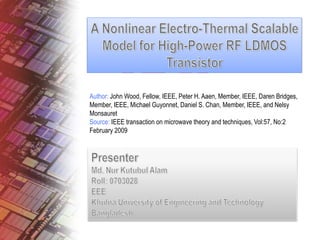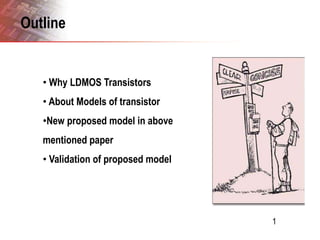A non-linear Electro-thermal scalable Model for High Power RF LDMOS Transistor
- 1. MM20 vs HVEKV LDMOS Model DC Only Evaluation Author: John Wood, Fellow, IEEE, Peter H. Aaen, Member, IEEE, Daren Bridges, Member, IEEE, Michael Guyonnet, Daniel S. Chan, Member, IEEE, and Nelsy Monsauret Source: IEEE transaction on microwave theory and techniques, Vol:57, No:2 February 2009
- 2. 02-0000 2 Outline ŌĆó Why LDMOS Transistors ŌĆó About Models of transistor ŌĆóNew proposed model in above mentioned paper ŌĆó Validation of proposed model 1
- 3. 02-0000 3 Why LDMOS Transistors Laterally diffused MOS is ŌĆó Field effect transistor ŌĆó High power transistor ŌĆó Performance & cost ŌĆó RF frequency 2
- 4. 02-0000 4 What is Model ŌĆó A way to read elements easily ŌĆó Is the process of generating abstract ŌĆó conceptual analysis 3
- 5. 02-0000 5 NLDMOS Structure with Scalable Ldrift Figure 2. HV-EKV model structure with built in Rdrift. Scalable Ldrift 0.8[um]~4.8[um] Figure 1. MM20 model structure with Rdrift VerilogA code. 4
- 6. 02-0000 6 The proposed Model Fig 3: Block representation of the transistor model 5
- 7. 02-0000 7 Equivalent Electrical Network Fig 4: New extrinsic network with the cold-FET intrinsic circuit for a transistor with total gate periphery of 4.8 mm 6
- 8. 02-0000 8 Nonlinear Intrinsic Model 7
- 9. 02-0000 9 S-parameters from Measurement vs Model Fig 5: Comparison between measured and modeled s-parameters 8
- 10. 02-0000 10 Load line under mismatched condition Fig 6: Load line for a Transistor operating under mismatched conditions supper-imposed upon the drain current (under pulsed operation) 9
- 11. 02-0000 11 ANNs for Function Approximation and Extrapolation Fig 7: Illustration of the various regions of the drain current. The measured characterization data is indicated by region I, while regions II and III represent the extrapolation and breakdown regions. 10
- 12. 02-0000 12 Prediction of device behaviour using ANNs Fig 8: Surface plot of the drain current as predicted by the full drain current model. The thick line indicates the range of voltages over which the drain current was measured. 11
- 13. 02-0000 13 Behaviour of Charge state function Fig 9: Plot of Qg versus Vds and Vgs. Outside the measured region indicated by the thick line, the charge surface predicted by the neural network is smooth and very well behaved, even at extremely high voltages, which would never experienced in practice, but may be used by the simulator during convergence. 12
- 14. 02-0000 14 Modeled and Measured Drain current and input power at different temperature Fig 10: Modeled and measured drain current is plotted at 25, 75 and 125 degree celsious as a function of applied gate voltage. Fig 11: Measured and modeled output power versus input power for bias current equal to 6 and 9 mA/mm 13
- 15. 02-0000 15 Validation of Model This EM Model - ŌĆó Is Nonlinear ŌĆó Is Temperature sensitive ŌĆó Has Optimized parameter ŌĆó Is in good agreement with experimental data 14
- 16. 02-0000 16 Conclusion ŌĆó New model is proposed ŌĆó Model is optimized from experimental data ŌĆó More perfect simulation is possible 15
- 20. 02-0000 20 19





![02-0000 5
NLDMOS Structure with Scalable Ldrift
Figure 2. HV-EKV model structure with built in Rdrift.
Scalable Ldrift
0.8[um]~4.8[um]
Figure 1. MM20 model structure with Rdrift VerilogA code.
4](https://image.slidesharecdn.com/0703028-140825072009-phpapp02/85/A-non-linear-Electro-thermal-scalable-Model-for-High-Power-RF-LDMOS-Transistor-5-320.jpg)














